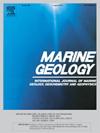Hydrodynamic processes and extreme events recognized from the sedimentary records at ancient Port Shuomen in the Oujiang River mouth, Southeast China
IF 2.2
3区 地球科学
Q2 GEOSCIENCES, MULTIDISCIPLINARY
引用次数: 0
Abstract
Identifying extreme events from geological records is fundamental to Paleotempestology. Archaeological excavations at the ancient Port Shuomen on the Southeast Chinese coast have provided high-resolution stratigraphic data for recognizing deposits associated with extreme events. This study examined three profiles from the Port and surficial sediments from modern colluvial and estuarine environments in the lower Oujiang River basin. Analyses including chronology, sedimentology, alkaline earth metal geochemistry, and ancient environmental DNA (eDNA) were performed on the sedimentary records to identify hydrodynamic processes and extreme events during the Song Dynasty (960–1279 CE). Comparisons of alkaline earth metal compositions between the profiles and surficial sediments suggest a reduction in salinity at the Port Shuomen, driven by increased freshwater discharge during the mid- to late-Northern Song Dynasty. High eDNA concentrations and consistent frequency distributions of fragment lengths further suggest rapid channel siltation during a single typhoon season. Following this typhoon season, the Port evolved into tide-dominated regime and experienced five periods of flooding, three of which were characterized by intensified salinity intrusion as evidenced by elevated Sr content. In particular, a mud unit (U10) exhibits the highest Sr content and is interpreted as a depositional record of extreme typhoon events that occurred in the 1160s CE. Furthermore, this study demonstrates that in estuarine environments, the preservation of eDNA is more impacted by sedimentary processes than grain size.

从中国东南部瓯江口古硕门港沉积记录中认识水动力过程和极端事件
从地质记录中识别极端事件是古气象学的基础。中国东南沿海的朔门古港考古发掘为识别与极端事件相关的沉积物提供了高分辨率的地层数据。本研究考察了朔门港的三个剖面以及瓯江流域下游现代冲积和河口环境的表层沉积物。对沉积记录进行了年代学、沉积学、碱土金属地球化学和古环境 DNA(eDNA)等分析,以确定宋代(公元 960-1279 年)的水动力过程和极端事件。对剖面和表层沉积物的碱土金属成分进行比较后发现,北宋中后期淡水排放量的增加推动了朔门港盐度的降低。高浓度的 eDNA 和一致的片段长度频率分布进一步表明,在一个台风季节,河道淤积迅速。在台风季节之后,港口演变为以潮汐为主的水系,并经历了五次洪水泛滥,其中三次洪水泛滥的特点是盐分入侵加剧,锶含量升高就是证明。其中,一个泥质单元(U10)的锶含量最高,被解释为公元 1160 年代极端台风事件的沉积记录。此外,这项研究还证明,在河口环境中,eDNA 的保存受沉积过程的影响比受粒度的影响更大。
本文章由计算机程序翻译,如有差异,请以英文原文为准。
求助全文
约1分钟内获得全文
求助全文
来源期刊

Marine Geology
地学-地球科学综合
CiteScore
6.10
自引率
6.90%
发文量
175
审稿时长
21.9 weeks
期刊介绍:
Marine Geology is the premier international journal on marine geological processes in the broadest sense. We seek papers that are comprehensive, interdisciplinary and synthetic that will be lasting contributions to the field. Although most papers are based on regional studies, they must demonstrate new findings of international significance. We accept papers on subjects as diverse as seafloor hydrothermal systems, beach dynamics, early diagenesis, microbiological studies in sediments, palaeoclimate studies and geophysical studies of the seabed. We encourage papers that address emerging new fields, for example the influence of anthropogenic processes on coastal/marine geology and coastal/marine geoarchaeology. We insist that the papers are concerned with the marine realm and that they deal with geology: with rocks, sediments, and physical and chemical processes affecting them. Papers should address scientific hypotheses: highly descriptive data compilations or papers that deal only with marine management and risk assessment should be submitted to other journals. Papers on laboratory or modelling studies must demonstrate direct relevance to marine processes or deposits. The primary criteria for acceptance of papers is that the science is of high quality, novel, significant, and of broad international interest.
 求助内容:
求助内容: 应助结果提醒方式:
应助结果提醒方式:


